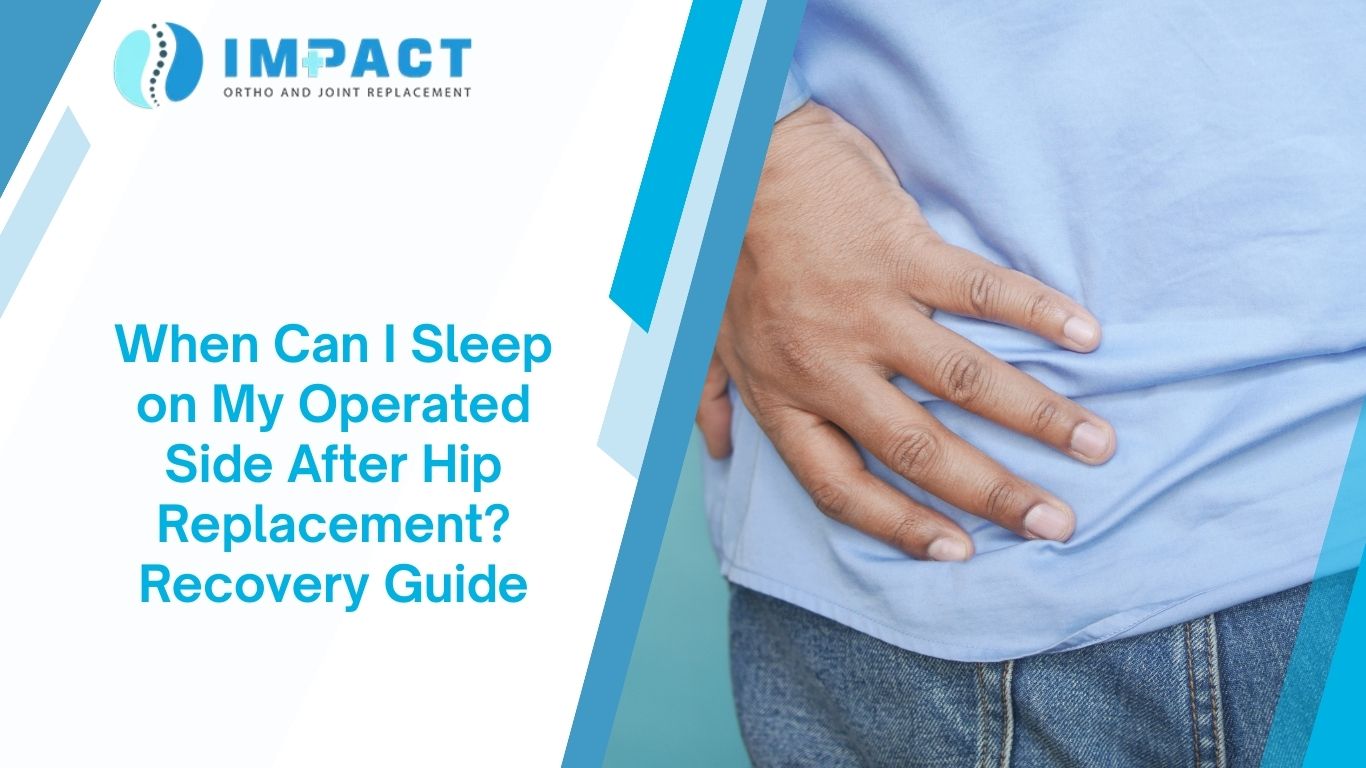Navigating recovery after hip replacement surgery can feel like a new frontier, and one of the most common questions is when can I sleep on my operated side after hip replacement? The short answer is: it depends on your surgeon’s specific instructions and the type of surgery you had. Generally, it’s advised to wait at least 6 weeks, but for some, it could be longer.
Let’s delve into this topic, offering a comprehensive guide to understanding your recovery and ensuring a safe return to your normal sleeping habits. This is a personalized journey, and understanding the “why” behind these restrictions is as important as the rules themselves.
The Importance of a Good Night’s Sleep After Hip Replacement
You’ve just taken a monumental step towards a pain-free life by undergoing a hip replacement. While you might be eager to get back to a sense of normalcy, including a comfortable night’s rest, it’s crucial to understand the rules of recovery. The quality of your sleep directly impacts your healing process. A well-rested body is a healing body. However, improper sleeping positions can put your new joint at risk, particularly in the early post-operative period. The primary concern is hip dislocation.
Understanding Hip Replacement Approaches and Precautions
The answer to when can I sleep on my operated side after hip replacement? is heavily influenced by the surgical approach your doctor used. There are three main types:
- Posterior Approach: This is a very common technique. The incision is made on the back of the hip. The surgeon works through the buttock muscles and tendons to access the hip joint. Post-operative precautions for this approach are the most stringent. To prevent the new hip from dislocating, you must avoid:
- Bending your hip past 90 degrees.
- Crossing your legs.
- Pivoting your hip inward (internal rotation).
- Anterior Approach: This approach is gaining popularity. The incision is made at the front of the hip. The surgeon works between muscles rather than cutting them, which may lead to a faster recovery and fewer restrictions. Post-operative precautions for this approach generally prohibit:
- Excessive hip extension (extending your leg back).
- External rotation (turning your leg outward).
- Anterolateral/Direct Lateral Approach: This approach involves an incision on the side of the hip. While it avoids some of the muscles from the posterior approach, it can still involve muscle splitting. Restrictions are typically less severe than with the posterior approach, but your surgeon will still advise on specific movements to avoid.
The most critical factor, regardless of the approach, is avoiding movements that could cause the new joint to pop out of its socket. The muscles and tissues around the new hip need time to heal and strengthen to provide the necessary stability. This is why you must adhere strictly to your surgeon’s guidelines.
When Can I Sleep on My Operated Side After Hip Replacement?
Recovering from hip replacement surgery can be challenging. Knowing the right time to sleep on your operated side is important for healing and comfort. Get expert advice tailored to your recovery journey.
Talk to a Hip Specialist TodayYour Sleeping Positions: The Early Weeks
In the immediate aftermath of your surgery, the goal is to protect the new joint at all costs. This means you will need to sleep on your back for the first several weeks.
Sleeping on Your Back
This is the safest and most recommended position during the initial recovery period. To make it more comfortable, try these tips:
- Pillow Support: Use a wedge pillow or a few regular pillows to slightly elevate your upper body and knees. This can relieve pressure on your lower back.
- Keep Your Legs Separated: Place a pillow between your knees to prevent them from crossing. This is particularly important if you had a posterior hip replacement, as crossing your legs is a major dislocation risk.
- Avoid Twisting: Make sure your entire body is aligned and you aren’t twisting at the hips. Keep your toes pointed straight up towards the ceiling.
It may feel strange if you’re not a back sleeper, but this position provides the stability your new hip needs to heal.
The Great Debate: When Can I Sleep on My Operated Side After Hip Replacement?
Now for the main event. The timeline for when you can safely sleep on your operated side depends on your surgeon’s unique instructions, but here are some general guidelines:
- Posterior Approach: Most surgeons will advise you to wait at least 6 weeks before attempting to sleep on your operated side. For some patients, this could be extended to 12 weeks or more. When you do, it’s vital to have a pillow between your knees and ankles to keep your legs parallel and prevent your hip from rolling inward.
- Anterior Approach: Because this approach is less disruptive to the muscles, some surgeons may allow you to sleep on your operated side as early as 2 weeks post-op, while others may still advise waiting for the 6-week mark. Always use a pillow between your knees and ankles for support.
It’s crucial to understand that even when your surgeon gives you the green light, a gradual approach is best. Try lying on your operated side for short periods first. If you experience any pain, discomfort, or instability, return to your back or unoperated side and consult with your surgeon.
Sleeping on Your Non-Operated Side
Sleeping on your unoperated side is often the first position you can transition to after sleeping on your back. Your surgeon will typically permit this around the 2-week mark or when you feel comfortable. To do this safely, you must still follow strict guidelines:
- Use a Pillow: Always place a pillow or a firm cushion between your knees and ankles to prevent your operated leg from crossing or rotating inward. This is the single most important safety measure for this sleeping position.
- Keep Your Hips Aligned: Make sure your hips are stacked one on top of the other and not twisted.
When Can I Sleep on My Operated Side After Hip Replacement?
Recovering from hip replacement surgery can be challenging. Knowing the right time to sleep on your operated side is important for healing and comfort. Get expert advice tailored to your recovery journey.
Talk to a Hip Specialist TodayUsing a Pillow for Support: Your Best Friend During Recovery
The pillow isn’t just a comfort tool; it’s a critical piece of medical equipment during your recovery. Using a pillow between your knees and ankles:
- Prevents Hip Dislocation: It keeps your legs from crossing and your hip from rotating, protecting the joint.
- Maintains Proper Alignment: It ensures your spine, hips, and knees are in a neutral position, reducing strain and discomfort.
- Reduces Pressure: It prevents your knees and ankles from rubbing against each other, which can be particularly uncomfortable after surgery.
A firm, long pillow or a specially designed abduction pillow is ideal for this purpose.
Beyond Sleeping: A Holistic Approach to Recovery
Your recovery is about more than just sleeping positions. It’s a holistic process that involves physical therapy, pain management, and a positive mindset.
Physical Therapy: Your Road to Recovery
Physical therapy is the cornerstone of your recovery. Your physical therapist will work with you to:
- Regain Range of Motion: They will guide you through exercises to restore your hip’s flexibility.
- Strengthen Muscles: They will help you build strength in your glutes, hamstrings, and quadriceps to support the new joint.
- Improve Balance and Coordination: This is essential for preventing falls, which could lead to re-injury.
- Teach Proper Movement Patterns: They will show you how to sit, stand, walk, and climb stairs safely to protect your new hip.
- Provide Personalized Guidance: They will answer your questions about daily activities, including when can I sleep on my operated side after hip replacement, based on your specific progress.
Pain Management and Comfort
Controlling pain is vital for your recovery and your ability to get a good night’s sleep. Your surgeon will prescribe pain medication, but you can also use non-pharmacological methods:
- Ice Packs: Applying ice to your hip for 15-20 minutes at a time can help reduce swelling and numb the area.
- Meditation and Relaxation: Stress and anxiety can heighten pain perception. Practices like deep breathing and mindfulness can help.
- Communication: Don’t hesitate to tell your doctor or physical therapist if your pain isn’t well-controlled.
Your Mental Well-being: A Crucial Component of Recovery
Recovery from hip replacement surgery is a marathon, not a sprint. It’s normal to feel frustrated, impatient, or even a little down. Remember to be patient with yourself and celebrate small victories.
- Stay Positive: Focus on your progress and the ultimate goal: a pain-free, active life.
- Lean on Your Support System: Friends, family, and caregivers are there to help. Don’t be afraid to ask for assistance.
- Set Realistic Expectations: Understand that healing takes time. Pushing yourself too hard too soon can lead to setbacks.
When Can I Sleep on My Operated Side After Hip Replacement?
Recovering from hip replacement surgery can be challenging. Knowing the right time to sleep on your operated side is important for healing and comfort. Get expert advice tailored to your recovery journey.
Talk to a Hip Specialist TodayFAQs: Your Questions About Hip Replacement Recovery Answered
How long do I have to use a pillow between my legs?
Most surgeons will recommend using a pillow between your legs for at least 6 weeks after surgery, especially when sleeping. For those who had a posterior approach, this may be extended to 12 weeks or longer, or until the surgeon gives the green light. The pillow is your best defense against dislocation.
Can I sleep with a regular pillow, or do I need a special one?
While a regular pillow can work, a firm, long pillow or an abduction pillow is often more effective at keeping your legs properly aligned and preventing them from crossing. Your physical therapist can recommend the best option for you.
What if I accidentally roll onto my operated side while sleeping?
If you wake up on your operated side, don’t panic. Gently and slowly roll back onto your back or unoperated side. Make sure you’re using a pillow between your knees to prevent this from happening in the future. The key is to avoid sudden, jerky movements.
When can I stop following my hip precautions altogether?
Your surgeon will tell you when you can relax your precautions. For most patients, this is around the 12-week mark, but some precautions, like avoiding extreme movements, may be advised for a longer period. It’s a gradual process, not a sudden change.
What is the most common cause of hip dislocation after surgery?
The most common cause of hip dislocation after a posterior approach is a combination of hip flexion (bending at the hip) past 90 degrees and inward rotation. For an anterior approach, it’s a combination of hip extension and outward rotation. It’s why following your hip precautions, even while sleeping, is so important.
Your journey to a full recovery after hip replacement is a team effort. By following your doctor’s instructions, especially regarding when can I sleep on my operated side after hip replacement, and committing to your physical therapy, you’re setting yourself up for the best possible outcome. The team at Impact Ortho is dedicated to guiding you through every step of this process, providing the expert care and support you need. Impact Ortho is your partner in achieving a successful recovery.
When Can I Sleep on My Operated Side After Hip Replacement?
Recovering from hip replacement surgery can be challenging. Knowing the right time to sleep on your operated side is important for healing and comfort. Get expert advice tailored to your recovery journey.
Talk to a Hip Specialist Today










